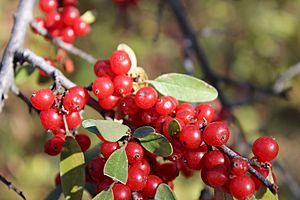Canada buffaloberry facts for kids
Quick facts for kids Canada buffaloberry |
|
|---|---|
 |
|
| Scientific classification | |
| Genus: |
Shepherdia
|
| Species: |
canadensis
|
| Synonyms | |
|
|
The Canada buffaloberry is a special plant known by many names. People also call it soopolallie, soapberry, or foamberry. In the Ktunaxa language, it's called kupaʔtiǂ. This plant is a type of bush that grows berries you can eat.
Contents
What is Canada Buffaloberry?
Canada buffaloberry plants usually grow red berries. But sometimes, you might find a type with yellow berries! These berries have a unique, slightly bitter taste.
This plant grows in many places. You can find it all over Canada, except for Prince Edward Island. It also grows in the western and northern parts of the United States, including Alaska and Idaho.
The Canada buffaloberry is a deciduous shrub. This means it's a bush that loses its leaves in the fall. It likes to grow in open forests and bushy areas. These bushes can grow to be about 1 to 4 meters (3 to 13 feet) tall.
How People Use Buffaloberries
Many First Nations peoples in Canada have traditionally collected these berries. For example, the Nlaka'pamux, Stʼatʼimc, and Secwépemc peoples in British Columbia gather them a lot.
The berries are quite bitter if you eat them plain. So, people usually prepare them in a special way. They make a dish called "sxusem" (also spelled "sxushem" or "hooshum"). This dish is sometimes called "Indian ice cream".
Making "Indian Ice Cream"
To make "Indian ice cream," people first spread a mat or tarp under the buffaloberry bushes. Then, they gently hit the branches to make the very ripe berries fall onto the mat.
Next, they mix these berries with other sweet fruits, like raspberries. They crush the mixture together. The most important step is beating the mixture until it becomes very foamy. This foam is a special part of the dish.
Taste and Health Notes
The "Indian ice cream" has a taste that is both sweet and a little bitter. Some people compare it to sweetened coffee.
First Nations peoples believe this dish has many healthy benefits. However, the foam in the berries comes from natural chemicals called saponins. If you eat too much of these saponins, they might make your tummy feel a little upset. Some restaurants in British Columbia have even offered buffaloberries on their menus.
It's important to know that there are other plants called "soapberry" (from the genus Sapindus) that are not related to Canada buffaloberry. Those other soapberries have very strong saponins and are not safe to eat.
Where the Name "Soopolallie" Comes From
In British Columbia, the common name for this plant is "soopolallie." This name comes from an old trading language called Chinook Jargon. This language was used in the Pacific Northwest in the 1800s and early 1900s.
The word "soopolallie" is a mix of two Chinook words: "soop" (which means soap) and "olallie" (which means berry). This name makes sense because of the foamy, soap-like texture the berries create when beaten.
Gallery
See also
 In Spanish: Shepherdia canadensis para niños
In Spanish: Shepherdia canadensis para niños




